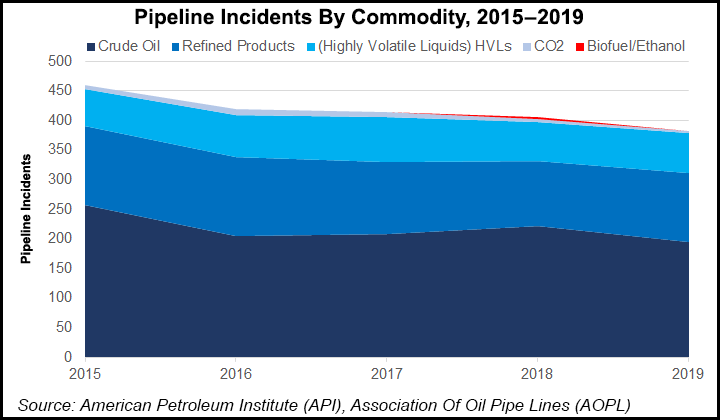Regulatory | Infrastructure | NGI All News Access | NGI The Weekly Gas Market Report
U.S. Pipeline Safety Report Reveals Fewer Incidents, More Infrastructure
Liquid pipeline incidents have decreased by 36% in the last five years even as pipeline mileage has increased by almost 10%, according to a review by energy industry groups.

The 2019 Pipeline Safety Excellence Performance Report was issued by the American Petroleum Institute (API), representing U.S. oil and natural gas industries, and the Association of Oil Pipelines (AOPL), which represents liquid pipeline owners/operators that transport petroleum and industrial products. The groups also issued a 2020-2022 strategic plan for the pipeline industry.
According to researchers, total pipeline incidents decreased 17% over the past five years. Additionally, pipeline incidents impacting people or the environment caused by corrosion, cracking or weld failure fell 50%, while incidents caused by equipment failure were down 15%.
Last year most pipeline incidents were relatively small in size, as almost two-thirds (64%) involved under 5 bbl, while 85% had less than 50 bbl. Large pipeline incidents occurred the least, as 5% of all incidents were 500 bbl or more. However, 16% of the incidents impacting people or the environment involved 500 bbl-plus.
The API and AOPL report also highlighted that liquid pipeline mileage increased by under 10% over the period. This included a 20% increase in crude oil pipeline, and a 35% increase in total bbl delivered.
The performance data was provided by the Pipeline and Hazardous Materials Safety Administration, which is used by API and AOPL each year to aid in creating their strategic plans for pipeline safety improvement. Industry-wide goals in their 2020-2022 Strategic Plan include promoting organizational excellence; improving safety through technology and innovation; increasing stakeholder awareness and involvement; and enhancing emergency response preparedness.
© 2024 Natural Gas Intelligence. All rights reserved.
ISSN © 1532-1231 | ISSN © 2577-9877 | ISSN © 1532-1266 |
